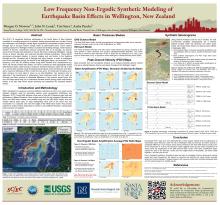Low Frequency Non-Ergodic Synthetic Modeling of Earthquake Basin Effects in Wellington, New Zealand
Morgan O. Newton, John N. Louie, Tim Stern, & Aasha PanchaSubmitted September 11, 2022, SCEC Contribution #12218, 2022 SCEC Annual Meeting Poster #222 (PDF)
The 2016 7.8 magnitude Kaikōura earthquake in the South Island of New Zealand consisted of a complex sequence of ruptures, lasting approximately two minutes. During the earthquake, the Wellington capital region experienced unexpected localized zones of damage due to focused seismic energy within its sedimentary basin. Some modern buildings adjacent to Wellington Harbour sustained devastating damage, while historical districts of low-rise unreinforced masonry sustained little to no damage. As seismic waves travel through soft sediments in basins like those underlying Wellington, energy moves at slower velocities and produces elevated shaking amplitudes. These effects accompany prolonged duration of ground shaking and are factors in the Kaikōura damage and the increased risk of damage and injury citywide. In order to understand how waves propagate through the basins of the Wellington region, we computed 27 low frequency (<0.6 Hz) 3D shaking models using SW4 software from Geodynamics.org. Three 3D velocity models were tested, one which contrasts an older geologically-based GNS Science basin model having a maximum sediment thickness under the city of 250 m, a second that included newly developed gravity-based model by Stronach and Stern with a maximum thickness of 540 m under the city, and a 1D model with no basins at all. Each scenario run took about 3 hours on an Intel MacBook. Our research aims to determine if the adjustments of sedimentary basin thickness under the city made by Stronach and Stern produce a substantial difference in how seismic waves travel. Not only will these results help us to understand focused seismic energy within sedimentary basins, it will also help inform hazard planning and preparation for expected seismic events.
Key Words
Wellington, New Zealand, ground shaking, basin effects, geotechnical, SW4, PGV map
Citation
Newton, M. O., Louie, J. N., Stern, T., & Pancha, A. (2022, 09). Low Frequency Non-Ergodic Synthetic Modeling of Earthquake Basin Effects in Wellington, New Zealand. Poster Presentation at 2022 SCEC Annual Meeting.
Related Projects & Working Groups
Ground Motions




